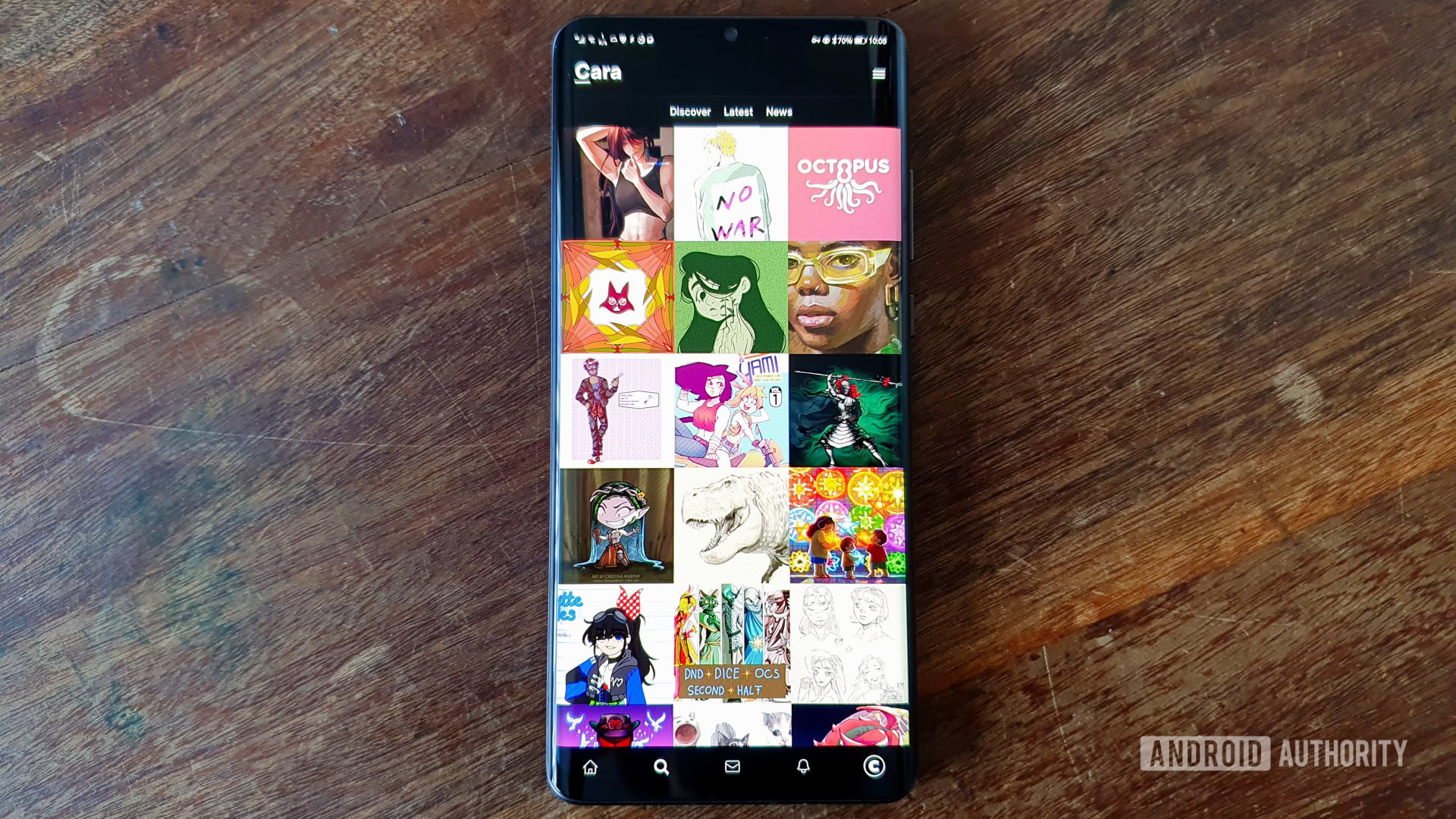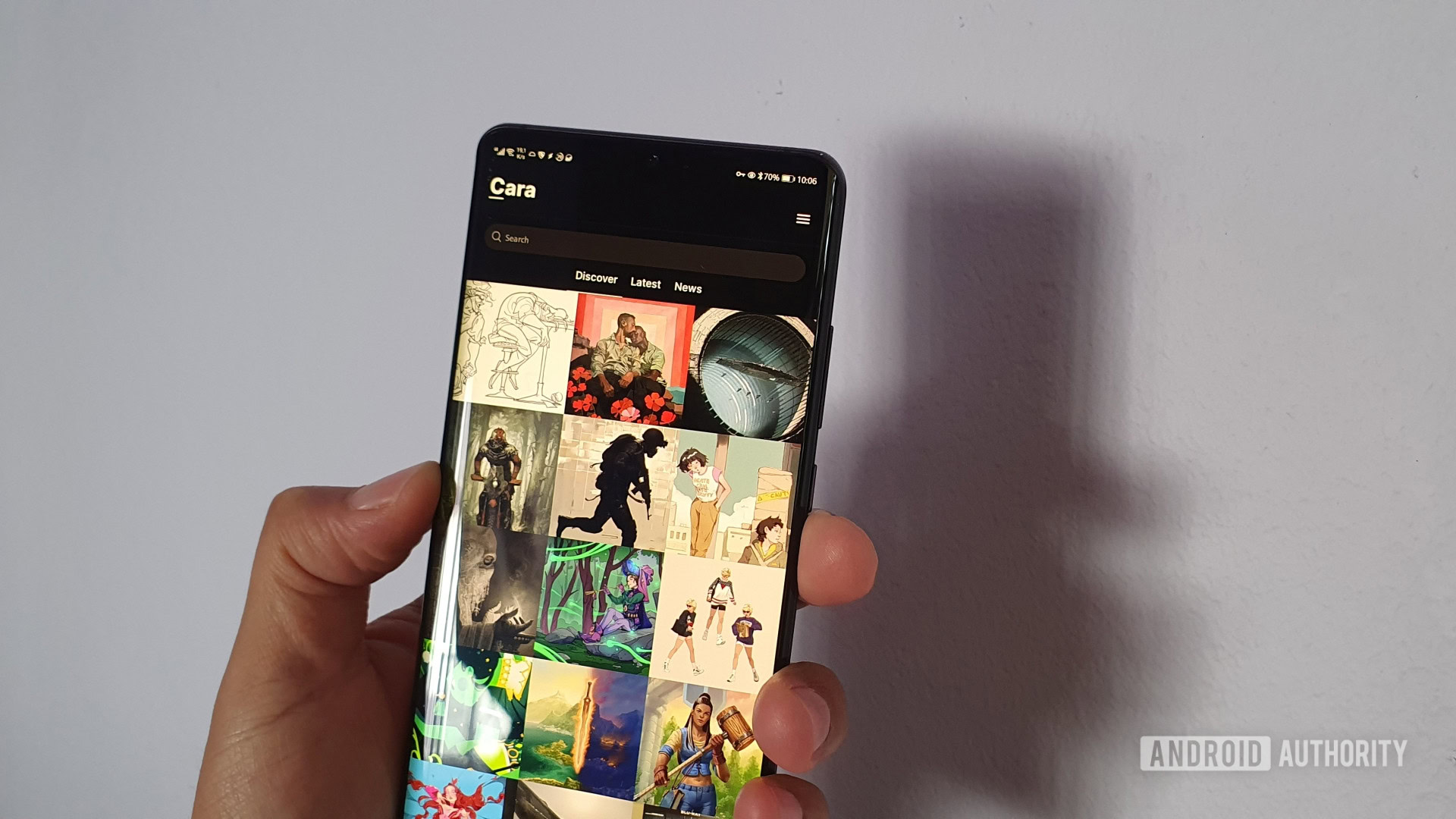
Andy Walker / Android Authority
Instagram, and social media as a whole, has an AI problem. Not only is the platform tagging real photos as created by AI, but it’s also using users’ creations to train its AI models. This, for an artist, is obviously worrying. In a world where generative AI is gathering momentum, and the lines between real and artificial are quickly blurring, it’s becoming more difficult for real artists to ply their trade. That’s where Cara steps in. The platform recently saw a surge in users, and I decided to give it a whirl, too.
What is Cara and who is it for?
Founded by photographer Jingna Zhang, Cara is a relatively new social network and app that aims to protect artistic integrity. Despite its focus on creators, Cara is available for all seeking out new and exciting artists or novel work. Like a digital art gallery, you don’t need to upload your own content to enjoy others’. You don’t even need an account if you browse online. I do love discovering new artists at markets and online, and I’ve found myself scrolling through the app much like I would Instagram or Reddit.
Its core tenet and principle draw is its stance on AI. The app currently prohibits generative AI works and implements safeguards to prevent AI models from scraping and training on data. In this sense, the platform appeals to those who want an authentic, AI-free portal to promote their work.
What Cara gets right
Cara also bills itself as a refuge from Instagram and other pro-AI social networks, but its design borrows heavily from the Meta app. This is a good thing, as the familiar UI streamlines the learning process. It took me a few minutes to familiarize myself with the app and with its home page.
The app is devoid of ads and puts the content first and foremost. It also provides plenty of options for users to browse and discover new work. I’m a huge fan of its Home Feed Settings option, which lets you choose in percentage increments what content you encounter on your home page. If you only want to see your friends’ artwork, you can do that. Want to see site-wide posts and a splash of your follower’s content? That’s possible too. All social networks could benefit from this quality-of-life toggle.
I can’t recall encountering a social network with a more supportive environment.
The profile page layout is another bright spot and foregrounds the promotion of artists. Users can broadcast their stance on accepting freelance work, commissions, or full-time positions if eager eyes come looking. Links are allowed too, making it easy for potential clients to navigate directly to an artist’s storefront. I’ve bookmarked more than a handful of creators I plan to purchase work from in the future. This pocketing functionality, which is separate from likes, makes it a great way to remember specific pieces, too, be it for your own inspiration or later referral. Hashtags also work well, plugging directly into the search functionality.
I want to touch on my experience on Cara beyond the art itself, though. A core part of the platform is its community. Like every social network, it’s the people that make it what it is. Unlike Instagram and X (formerly Twitter), comments left on Cara posts are remarkably supportive. I haven’t yet encountered one toxic comment. Perhaps this is thanks to its core ethos, but Cara is largely devoid of political commentary, harassment, toxic remarks, and hateful echo chambers. I can’t recall encountering a social network with a more supportive environment.
As its a smaller, more condensed community, it encourages the discovery of art from artists you wouldn’t otherwise encounter. This makes it easier for smaller artists to garner a following, as opposed to Instagram where the sheer number of users and its algorithm may limit potential reach.
What do you think of Cara?
12 votes
It’s not quite there, yet

Andy Walker / Android Authority
As you’ve probably gathered, I love the idea of Cara. A place that fosters creativity and harbors a supportive net of users who all share the same love? Count me in. However, for all of its positives, Cara isn’t exempt from critique.
There are practical flaws. Even though Cara allows text posts up to 5,000 characters long, the platform’s current focus is visual art. Unfortunately, this makes it more inhospitable for other creative projects. Text posts aren’t as easy to search for as visual content, which makes finding poetry and short stories difficult. Users can post their poetry as an image to get around this, but it’s an extra step.
I found issues with image quality too, especially when zooming into images. Granted, there has to be some compression, but visual platforms should put visual fidelity first.
It’s important to address the elephant in the room: what is Cara’s trajectory?
Finally, it’s important to address the elephant in the room: what is Cara’s trajectory? It’s not a social media platform in the traditional sense. I feel the app has more in common with an art subreddit than Instagram. You won’t use it to keep up with a friends’ travel photos, see specific images from a place or event, or more general imagery from internet users. In this sense, don’t expect Cara to ever become a true Instagram alternative.
I worry about its feasibility. In its current guise, the platform appears to be unsustainable. In an interview with Wired, Zhang noted that the platform’s hosting bills are mounting. The small development outfit was considering implementing a subscription service, but this may inadvertently dissuade people from joining.
Cara may have too narrow a reach to be a truly viable social platform, but rapid growth also leaves it with unsolved issues. The platform no doubt strengthens artist-to-artist collaboration, but I doubt it’ll spawn an anti-AI social media revolution. I’m not sure if that’s what Cara or its creators want, either. The platform is designed for artists by artists, and this makes it inherently niche. But can Cara survive without casual users? Can digital art survive without casual browsers? I’m not so sure, but regardless, I enjoy drawing inspiration from the platform. I might even take up doodling again.
